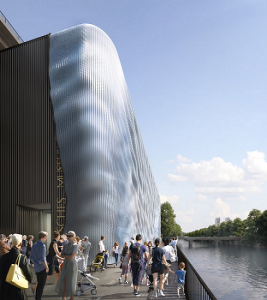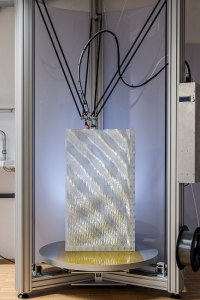Two years ago, we told you about one of the world’s first 3D printed, functionally integrated building façade elements. The concept of a 3D printed translucent façade was developed by a team of researchers at the Technical University of Munich (TUM) now at 3F Studio. The German-based start-up, founded by Moritz Mungenast, Oliver Tessin and Luc Morroni, originates of the research project Fluid Morphology, a multifunctional, translucent 3D printed façade application, developed at the Associate Professorship of Architectural Design and Building Envelope at the Technical University of Munich (TUM), and specialises in 3D Printed performative architecture and design.
 The team obviously planned and designed their façade concept, called Fluid Morphology, so that it would appear very fluid, but interestingly enough used a very deliberately designed wave structure. The multifunctional elements of the translucent façade were designed for digital fabrication, so that building designers could have total freedom in making these integrated façade elements. Not only do these architectural features look beautiful, but they’re functional as well, offering the interior of a building insulation, shade, and ventilation.
The team obviously planned and designed their façade concept, called Fluid Morphology, so that it would appear very fluid, but interestingly enough used a very deliberately designed wave structure. The multifunctional elements of the translucent façade were designed for digital fabrication, so that building designers could have total freedom in making these integrated façade elements. Not only do these architectural features look beautiful, but they’re functional as well, offering the interior of a building insulation, shade, and ventilation.
“but how much light really penetrates the new, printed facade elements, and where? how resistant are they to UV radiation and the stress of wind, rain and snow? how efficiently do they insulate? long-term measurement of a complete facade element in the solar station, a testing installation on the main building of the TUM in munich’s arcisstraße, is to provide the answers to these questions,” the design team stated. “over a period of one year, sensors will collect data used to improve the design before creating further prototypes made of polycarbonate, a material certified for use in facades.”
Now that this testing period has been completed, the team’s 3D printed façade concept can go out into the real world. The complete façade for the museum will be divided into square meter panels weighing about 10 to 15 kg each. Within its six to eight cm material thickness, air-filled cavities will offer optimum insulation and structural integrity to the building, while bulges and the previously mentioned textural waves create shadows for shade. Thin, integrated tubes inside the 3D printed façade will make it possible for air to circulate from one side of the element to the other for optimal ventilation.
- Translucent building panels 3D printing
- Moritz Mungenast
All of these functions are adaptable, so that they can accommodate any building requirements, and also operate across any scale. Additionally, only minimal post-processing will be required, so the 3D printed façade elements can be directly installed, and because no support structures are needed, the team also saves on material.
The 45 x 15 meter façade, which will be 3D printed out of PETG material and weigh approximately 8,000-12,000 kg, is scheduled to envelop the museum’s new entrance by October of 2020. The museum is also undergoing a larger renovation, which will be led by Schmidt-Schicketanz und partner (SSP).
Discuss this story and other 3D printing topics at 3DPrintBoard.com, or share your thoughts in the Facebook comments below.
[Source: designboom / Images: TUM’s Andreas Heddergott, unless otherwise noted]Subscribe to Our Email Newsletter
Stay up-to-date on all the latest news from the 3D printing industry and receive information and offers from third party vendors.
You May Also Like
New Report: Semiconductor Industry to See $1.4B in 3D Printing Revenues by 2032
“The semiconductor sector has become the most strategically significant area of global industry.” Truer words are hard to come by when it comes to the modern world, and they are...
Will Photonic-Crystal Lasers Revolutionize 3D Printing?
Powder bed fusion (PBF) for metals and polymers predominantly utilizes lasers as the primary heat source. Some directed energy deposition (DED) technologies also employ lasers, while various vat polymerization methods...
3D Printing Unpeeled: Orbex Investment, IndoMIM and HP, Ultrasonic Waves
INDO-MIM has bought three HP Metal Jet S100 printers, operating two in India and one in Texas. This is a win for HP because the company has deep experience in...
3D Printing Webinar and Event Roundup: April 21, 2024
It’s another busy week of webinars and events, starting with Hannover Messe in Germany and continuing with Metalcasting Congress, Chinaplas, TechBlick’s Innovation Festival, and more. Stratasys continues its advanced training...



































